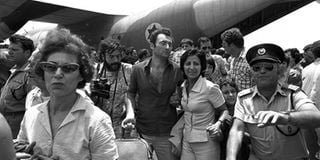Left Behind: How Israeli hostage Dora Bloch met her tragic death

Hostages disembark from the rescue plane on their return to Israel.
Among the hostages on the hijacked Air France plane was an elderly lady called Dora Bloch, a British-Israeli citizen. She was said to have choked on a piece of meat on the plane and had difficulties in breathing. To that effect, she was rushed to Mulago hospital on landing at Entebbe airport.
John Kato in his book The Eight Years of Tension says Bloch was increasingly worried about the fate of her son whom she had left at Entebbe. When news of the raid reached the hospital on the morning of July 5, Kato writes, the hospital authorities became so worried about the fate of the poor lady who had been left behind and they agreed to protect her.
That morning, Bloch asked the hospital staff for a gown so that she could wash the dress she had been wearing for the last couple of days.
News of the British-Israeli national who had been left behind started spreading. Peter Chandley, the second secretary of the British High Commission, paid her a visit. The hospital authorities allowed them to talk for some minutes.
Bloch then asked Chandley to get her some European food since she was not used to the local food she had been eating. Chandley left to bring her food.
Arrest and execution
But before the food could be delivered, Kato says elements of the State Research Bureau arrived at the hospital premises in two cars. Two of them were well known, the State Research Bureau chief and perhaps the most feared at the time, Maj Farouk Minawa, and chief of protocol to the president, Capt Nasur Ondoga, dressed in civilian attire, emerged from the car and marched straight to the causality room, armed with pistols.
Minawa in the lead kicked the causality room door, sending it flying before entering the room and shouting at the medical staff to stand aside. They grabbed Bloch from the bed, holding both arms, and dragged her outside as she screamed through the corridor. She was thrown into the car boot before being driven off, Kato writes.
No account is told of what happened to Bloch after that, but her body was dumped 20 miles on the Kampala-Jinja highway. To mystify the evidence, Kato says her body was badly burnt, but somehow her white hair had survived the fire, making it clear to those who had heard of her arrest.
As news of Bloch’s disappearance saturated the following morning, the British High Commission started inquiries into her whereabouts. That morning, Kato says, Amin called the hospital authorities and warned that if anybody called asking for the old lady, they should say she had been taken back to the airport an hour before the Israelis attacked and she could have been taken along with other hostages.
Kato, however, writes that this was complicated since the records of her discharge were absent and the entire medical staff and other patients had witnessed her arrest.
Amin then ordered a fabrication of records which was immediately done by the responsible medical staff much as they knew the bitter truth.
International pressure soon started mounting on Amin’s government to produce clear information about Bloch’s disappearance, forcing Amin to appoint a commission of inquiry.
It regularly reported that according to its findings, Bloch had been returned to Entebbe from where she had been taken along with the rest of the hostages.




